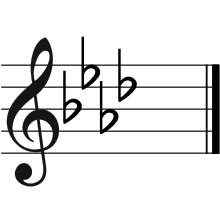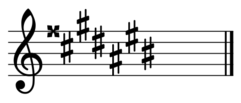F minor
F minor is a minor scale based on F, consisting of the pitches F, G, A♭, B♭, C, D♭, and E♭. Its key signature consists of four flats. Its relative major is A-flat major and its parallel major is F major. Its enharmonic equivalent, E-sharp minor, has eight sharps, including the double sharp F![]()
 | |
| Relative key | A-flat major |
|---|---|
| Parallel key | F major |
| Dominant key | C minor |
| Subdominant | B-flat minor |
| Component pitches | |
| F, G, A♭, B♭, C, D♭, E♭ | |
The F natural minor scale is:
Changes needed for the melodic and harmonic versions of the scale are written in with accidentals as necessary. The F harmonic minor and melodic minor scales are:
Music in F minor
Famous pieces in the key of F minor include Beethoven's Appassionata Sonata, Chopin's Piano Concerto No. 2, Haydn's Symphony No. 49, La Passione and Tchaikovsky’s Symphony No. 4.
Glenn Gould once said if he could be any key, he would be F minor, because "it's rather dour, halfway between complex and stable, between upright and lascivious, between gray and highly tinted... There is a certain obliqueness."[1]
Helmholtz once described F minor as harrowing and melancholy. Schubart described this key as "Deep depression, funereal lament, groans of misery and longing for the grave". [2]
Notable compositions
- Antonio Vivaldi
- "Winter" from The Four Seasons, RV 297
- Johann Sebastian Bach
- Harpsichord Concerto No. 5
- "Ich ruf zu dir, Herr Jesu Christ", BWV 639
- Joseph Haydn
- Symphony No. 49, La Passione
- Variations in F minor
- Wolfgang Amadeus Mozart
- Ludwig van Beethoven
- Egmont Op. 84: Overture in F Minor
- Piano Sonata No. 1, Op. 2/1
- Piano Sonata No. 23 (Appassionata), Op. 57
- String Quartet No. 11 "Serioso", Op. 95
- Felix Mendelssohn
- Frédéric Chopin
- Charles-Valentin Alkan
- Franz Liszt
- Funérailles
- Transcendental Etude No. 10 "Appassionata"
- Mazurka In F Minor S.221a
- Franz Schubert
- Fantasia in F minor
- Impromptu No. 1, Op. 142
- Impromptu No. 4, Op. 142
- Johannes Brahms
- Piano Quintet Op. 34
- Piano Sonata No. 3 Op. 5
- Pyotr Ilyich Tchaikovsky
- Symphony No. 4
- [The Tempest (Tchaikovsky)|]]
- Anton Bruckner
- Alexander Borodin
- Paul Dukas
- Dmitri Shostakovich
- Symphony No. 1
- String Quartet No. 11 Op. 122
E-sharp minor
 | |
| Relative key | G-sharp major |
|---|---|
| Parallel key | E-sharp major |
| Dominant key | B-sharp minor |
| Subdominant | A-sharp minor |
| Enharmonic | F minor |
| Component pitches | |
| E♯, F | |
E-sharp minor is a theoretical key based on the musical note E♯ and consisting of the pitches E♯, F![]()
The E-sharp natural minor scale is:
Changes needed for the melodic and harmonic versions of the scale are written in with accidentals as necessary. The E-sharp harmonic minor and melodic minor scales are:
Its relative major is G-sharp major, which is usually replaced by A-flat major. Its parallel major, E-sharp major, is usually replaced by F major, due to the presence of 4 double-sharps in the E-sharp major scale causing it to be one of the more impractical key signatures in music to use. Although E-sharp minor is usually notated as F minor, it could be used on a local level, such as bars 17 to 22 in Johann Sebastian Bach's The Well-Tempered Clavier, Book 1, Prelude and Fugue No. 3 in C-sharp major. (E-sharp minor is the mediant minor key of C-sharp major.)
See also
- Key (music)
- Major and minor
- Chord (music)
- Chord names and symbols (popular music)
Notes
- Cathering Meng, Tonight's the Night (Apostrophe Books, 2007): 21
- https://www.wmich.edu/mus-theo/courses/keys.html